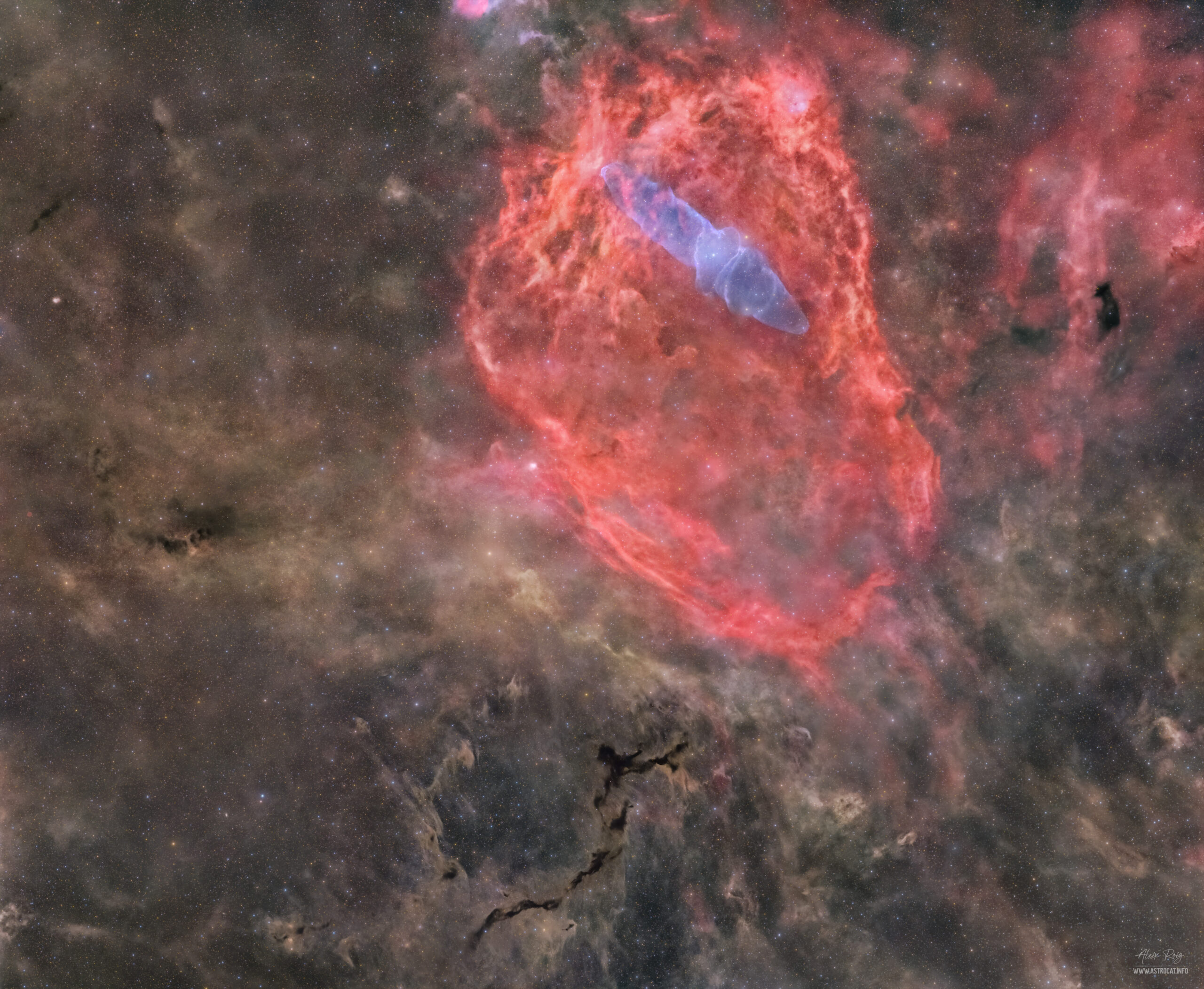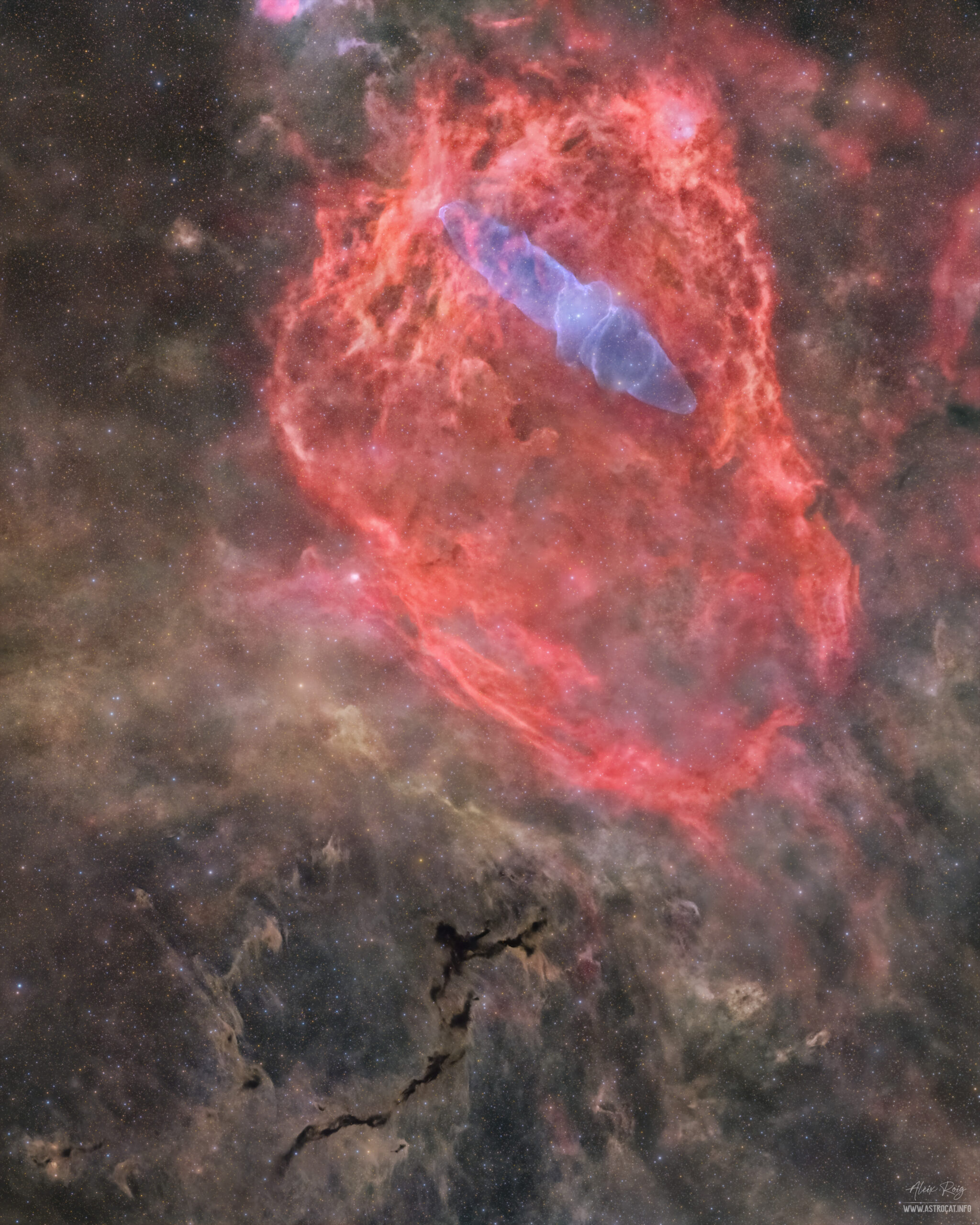Barnard 150, also catalogued as LDN 1082, is a dark nebula located some 1,200 light-years from Earth. Unlike emission or reflection nebulae that emit or reflect light, dark nebulae are composed of dense, cold gas and dust that block the light from objects or stars behind them. They are often seen as inky, black patches against the background of brighter stars or nebulae.
Also known as the Seahorse nebula, it takes the name due to its shape that appears against a rich, luminous background field of stars.
The Squid nebula, also called Ou4, was discovered back in 2011 by Nicolas Outters. It’s a really faint object that covers around one degree in the night sky, but it can only be detected through deep image integrations. It’s apparently surrounded by the reddish hydrogen emission nebula catalogued as Sh2-129. The distance of Ou4 from Earth is still unknown, although some recent studies indicate that it does lie within Sh2-129 some 3,200 light-years away. The squid would represent a spectacular outflow of material driven by a triple system of hot, massive stars, catalogued as HR8119, seen near the center of the nebula. This giant squid is 50 light-years across.
About this image:
This image has been captured from my backyard observatory, located in Prades, with the use of all my 3 telescopes and monochrome cameras that have worked as a team to produce this 142 hour 55 minute exposure image.
Back in September 2023 I published two separate images of the nebulae Barnard 150 and Ou4 using my double Takahashi FSQ setup. By that time I wondered if I was able to take a wide field image mosaic with my third refractor telescope, a FRA300.
By then I started capturing data for a two panne mosaic image that has finally covered an area of almost 14 full moons in diagonal, allowing me to show both celestial objects in one single image in the context of the rich molecular cloud of gas that surrounds them.
Link to the B150 FSQ’s image: https://astrocat.info/barnard-150-seahorse-in-cepheus-new-edition/
Link to the Ou4 FSQ’s image: https://astrocat.info/cosmic-squid-ou4/
Image processing:
Great part of the process has been to compose the two pane mosaic that came directly from my FRA300 telescope. I added to those pane the details from the double FSQ setup in order to get a better SNR. I also used the [OIII] data from my FSQ85 to highlight the faint Our4, Squid nebula. I did all that pre-processing using the Astropixel Processor program.
Once I had the mosaic panes calibrated, stacked and stitched for all the corresponding channels R, G, B, L, Ha, [OIII], I moved to Pixinsight to follow my usual workflow. I applied the new release of BlurXterminator 2.0 AI4 with the linear images just out of APP.
Final layer processing has been done using Photoshop in order to properly add the [OIII] details in the upper part of the image and to incorporate the stars. Final curves and contrast has also been done with PS.
The full image shown above covers an area of 5º21′ x 4º23′ at a resolution of 2.59″/pixel.
Thanks for taking your time on this site.
Image Details
FRA300 mosaic:
L: (155 + 187) x 300″ (28h 30′)
Ha: (40 + 64) x 300″ (8h 40′)
RGB: 2 x 60 x 30″ each channel (3h)
Calibrated with darks, flats. dark-flats.
Total exposure FRA300: 40h 10′
Dual Takahashi FSQ’s images:
Barnard 150, Seahorse nebula
FSQ106:
L: 403 x 300″ (33h35′)
FSQ85:
Ha: 341 x 300″ (28h25′)
Ou4, Squid nebula
FSQ106:
Ha: 193 x 300″ (16h 05′)
FSQ85:
[OIII]: 296 x 300″ (24h 40′)
Calibrated with darks, flats and dark-flats.
Total exposure Dual FSQ: 102h 45′
TOTAL EXPOSURE: 142h 55′
Moon at 25% (on average)
Image resolution: 2.59”/pixel
FOV (full image): 5º21′ x 4º23′
Equipment
FSQ106 EDX4 + ASI2600MM + LRGB Astrodon filters + Ha3nm Antlia – with ZWO EFW 7 pos
FSQ85 + ASI294MM + SHO LRGB Baader filters – with ZWO EFW 8 pos
Mesu200 mount
Guiding with ASI120MM and ZWO Mini Guide Scope
FRA300 + ASI2600MM + LRGB ZWO filters + ZWO EFW 7 pos + ZWO EAF
ZWO AM5 mount
ASI AIR Plus
Guiding with ASI120MM and ZWO Mini Guide Scope
Software
SGP, PHD2, APP, PIX, LR, TPZ, PS.
Aleix Roig, January 2024
Prades (Tarragona, Catalonia – Spain).
Full HD image on Astrobin.


